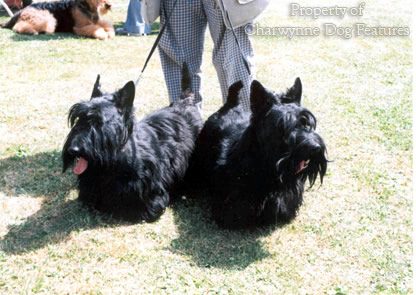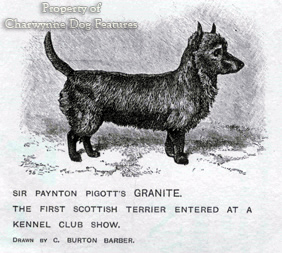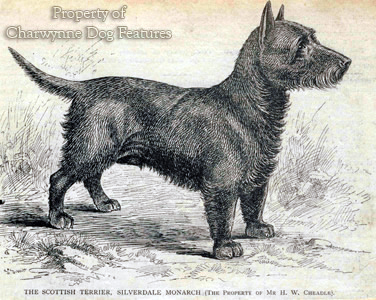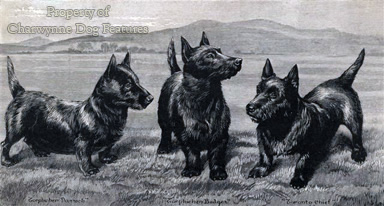760 Saving The Scottie
SAVING THE SCOTTIE
by David Hancock
 “Let the first thing aimed at in breeding be a dog that is palpably an active, intelligent creature, capable of doing a good day’s work over rough country, and in all sorts of weather, and then endeavour to attain perfection in his appearance as a whole, and not as a conglomeration of points. If this be done, we need have no fear of the future of the sturdy little Hielander.” Those words were used by pioneer Scottie breeder WL McCandlish in his The Scottish Terrier, Our Dogs Ltd, c.1
“Let the first thing aimed at in breeding be a dog that is palpably an active, intelligent creature, capable of doing a good day’s work over rough country, and in all sorts of weather, and then endeavour to attain perfection in his appearance as a whole, and not as a conglomeration of points. If this be done, we need have no fear of the future of the sturdy little Hielander.” Those words were used by pioneer Scottie breeder WL McCandlish in his The Scottish Terrier, Our Dogs Ltd, c.1928. They came back to me a few days after studying the entry at first a hunt terrier show and then a Kennel Club championship show on terrier day. McCandlish might not have found his perfection of appearance at the former show but I feel he would have been depressed at the KC show, to view his much-loved breed 80-odd years on. The KC show was held on a warm day and the exhibits in the Scottie ring were panting, not from the heat of the day, but from the needless wealth of coat bestowed upon them by those who favour this breed so much they want it to have no chance of succeeding as a sporting terrier. I wondered what the length and texture of this appealing little breed might be like in another 80-odd years of show ring excess.

If you look at portrayals of early show Scotties like HW Cheadle’s Silverdale Monarch, Sir Paynton Piggott’s Granite and Arthur Wardle’s depiction of the breed in 1890, you see a very different dog. First of all, a sporting terrier must have the anatomy that allows it to act as just that, a terrier to be used in the field. An earth-dog needs a minimum length of leg both to be active below ground and to dig. A cloddy dog has problems negotiating narrow underground passages. A broad-chested terrier is needlessly handicapped by dimensions alone. A straight front in a short-legged breed doesn’t permit a strong digging action. A short back inflicts a lack of eel-like elasticity so desirable in an earth-dog. A long thick woolly coat is a dreadful handicap for any working dog in any sporting field. Why then favour it in this breed?
Looking at the entry of this breed in KC show rings today, brings back the words of Thomson Gray in his The Dogs of Scotland of 1891: “Previous to 1879 the type of terrier now recognized as the ‘Scotch’ terrier was comparatively unknown. This is not surprising when we recollect that they were in the hands of sportsmen, fox-hunters, gamekeepers, and crofters, living in remote parts of the Highlands and islands of Scotland, far removed from the influence of dog shows, and having little communication with the world.” When it was in the hands of sportsmen the breed had the capability of being a sporting terrier; now that is entirely in the hands of show breeders it has lost that fundamental capability. Show breeders may not want their terriers to be earthdogs but they should breed them true to type and pay homage to the remarkable men who created such an admirable little breed.
McCandlish also wrote in his book on the breed of nearly a century ago: ‘The first aim of a breeder should be to produce the dog best fitted to be the companion of man in and out of doors…I should like to shoot all breeders of Scottish Terriers who breed dogs to suit judges, those who tell you, for instance, that you must breed for straight fronts and short backs, because such judges insist on these two catch-penny phrases, even though they are fully aware that to obtain these two subsidiary features they must ignore expression and intelligence, type of body, and true activity.’ A visitor to his kennel in1905 reported her delighted amazement on seeing a couple of dozen Scotties that all looked completely uniform in appearance. Before the First World War, his was the leading kennel, bringing symmetry, well-balanced heads and neat ears, stronger quarters with muscular thighs, strongly-rooted tails and a balanced build without losing earth-dog attributes too, no mean feat. McCandlish favoured an 18lb dog, nowadays the standard asks for a 19-23lb dog.
The popularity of this appealing little Scottish breed is now down to just over 800 a year being registered with the Kennel Club; in 1989 and again in 1990 there were over 2,000 registered – and nearly that number as far back as1927. The knowledgeable Swedish judge who acted at the Scottish Terrier Breeders & Exhibitors Association show in March, 2011, reported that: “Fronts are still a problem and so is size. A Scottie should be a sturdy dog of quality, not overly big, coarse and clumsy, and this is an important distinction.” You could argue that no sporting terrier needs to be stu rdy and that fronts are a problem in nearly every show ring terrier breed, but for this judge to stress the importance of avoiding big, coarse, clumsy specimens is significant. Today’s show Scottie is too heavily coated, too heavy in build, too stilted in movement through limited forward extension and all too often over-boned. Perhaps they should now just be called Scotties and the word terrier dropped from their breed title. With these physical handicaps, sporting terriers they ain’t! Come on, patriotic Scottish sportsmen, step forward and save these potentially game, once much-favoured, small dogs of Scotland, McCandlish’s ‘little Hielanders’; they’re worth it!
rdy and that fronts are a problem in nearly every show ring terrier breed, but for this judge to stress the importance of avoiding big, coarse, clumsy specimens is significant. Today’s show Scottie is too heavily coated, too heavy in build, too stilted in movement through limited forward extension and all too often over-boned. Perhaps they should now just be called Scotties and the word terrier dropped from their breed title. With these physical handicaps, sporting terriers they ain’t! Come on, patriotic Scottish sportsmen, step forward and save these potentially game, once much-favoured, small dogs of Scotland, McCandlish’s ‘little Hielanders’; they’re worth it!
